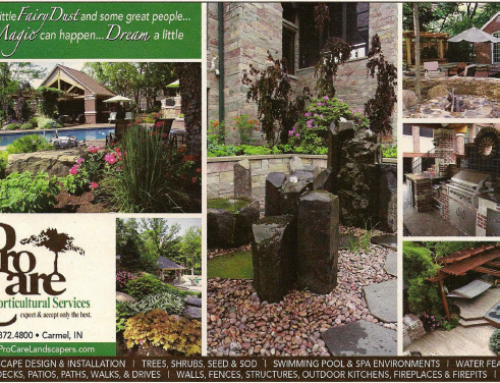Everyone knows that first impressions are lasting impressions. In order for your home to stand out from the rest, it must include a landscape plan that offers instant curb appeal and a style all its own. Even homes that have similar floor plans and exteriors can look completely different with the right live material and hardscape treatment.
“It’s amazing how much one house can be altered by landscaping,” says Lowell Rolsky of ProCare Horticultural Services, who recently completed landscaping projects on two properties that included “sister” houses with flipped floor plans created by the same builder.
A RELAXING RETREAT
Like all of his projects, Rolsky started by asking the homeowners about their lifestyle and personal needs. He says because homeowners live and interact with their landscapes, it is important to take those thoughts into consideration before embarking on a project. Some homeowners want their plans implemented in stages, while others want everything to look
great now. Families with children and pets might require hardy “kill proof” plant material,
while hobby gardeners may want to experiment with exotic species.
“Everyone’s needs and desires are different and that is a critical aspect of the job,” Rolsky says. “We have to focus our attention on how the homeowners are living and what they are truly looking for, then create the reality of it.”
Sue Kozlowski had a definite vision of what she and her husband wanted when they relocated to central Indiana. The well-traveled couple was intrigued by the home they found in Zionsville that evoked a Colorado retreat.
Rolsky says the Kozlowskis purchased their “dream home” while it was still under construction and planned a number of amenities for the property; including a vegetable garden, swimming pool, and patio. They also wanted to make sure that the
landscape style complemented the home’s mission-style architecture, and contained
a lot of out-of-the-box thinking.
“I jokingly told them to buy the property behind them and install a mountain,” then, says Rolsky, “it would have fit right in with that style of home. Of course, that didn’t happen, but they did want more mature plantings that would look great right away rather than installing something with potential that might look great years down the line.”
One of the biggest challenges on the property was the expansive backyard, which ·needed to be modified to fulfill its potential. Rolsky says that he created rolling hills in the back, and included a variety of gardening styles that the couple had enjoyed while traveling across the country.
“We were continually saying that we didn’t know a backyard could look like that,” says Kozlowski. “Every month there was something coming up in the yard. There were areas that drew hummingbirds and cardinals. We had cherry blossoms and maple trees in addition to
the fountain and rocks that were brought in from California. Lowell brought it all together in one vision. There is a beautiful view from every room of the house.”
STAGED TO PLEASE
Nimu Surtani didn’t know much about landscaping when he moved into his Arts
and Crafts style home in Noblesville, but when his budget changed after he had
lived in the space for a while, he decided to freshen up his initial landscape design.
He also knew it could take y ears for the landscape’s plants to reach maturity, and
in the meantime, the home looked like a monolith compared to its surroundings.
He was aware that his home had a sister in the area. When he saw what had been done on the other property, he called in Rolsky to balance his home with its surroundings, scale it with the landscaping, and make it appear smaller.
Rolsky analyzed the property and, working in stages, integrated hardscapes and added dimensions to immediately soften the home’s position on the land. Surtani was impressed by Rolsky’s ability to look at the property in a number of different ways and determine what views he could create and what colors would show, and then envision the end result.
“It must have taken a tremendous amount of work, but I think that is the separation between a landscape architect and an artist,” says Surtani. “When you get a designer with an artist’s eye, it makes all the difference. They really can transform the way a house looks.”
“Homeowners always have an idea of how they want something to look, but they turn to a designer because we can look at things in a unique way,” says Rolsky.
Even homes that use similar plant material can look altogether unique depending on how it is laid out. Surrounding properties can make a significant difference as well. One of the homes had neighbors nearby, and while the other also had neighbors, it was more isolated.
Open fields caused wind problems, so plant selections were limited. Privacy was also important for both houses. Surtani’s house required a spa area for entertaining guests-but without a claustrophobic feel. Rolsky was grateful for the confidence the homeowners showed him on both projects.
“We were told that it was unusual that we gave him free reign, but I liked what he did on the other home,” says Surtani. “When you look at some of the plant names, they really mean nothing to a layperson. He knew best what the project would do for the view from inside the
house, and I had no business interjecting in that expertise. I knew we wanted aesthetics,
and, in the end, what we got was a lovely Arts and Crafts lodge with an asymmetrical landscape design. When he walked away from it, it looked beautiful. When it comes to landscaping, you really !let what you pay for.”
LOOK AT THE BIG PICTURE
Rolsky says homeowners need to consider a long term goal. Landscaping is a living breathing process that doesn’t have to happen overnight. As long as one plans to be in a home for 10 years or longer, a landscape design will offer a personal return on investment that can be realized immediately-or over a period of time.
He also says a plan that is implemented in stages allows a homeowner to move toward a goal (as opposed to a plan for people who want to see a finished look right away). The objective is to find a designer who can create a strategy that undersells and over delivers, and encourages clients to continue the process.
“When you know that you are making people happy,” he says, “it is great to see their reactions after you take nothing and turn it into something. There is no better reward.”




Leave A Comment